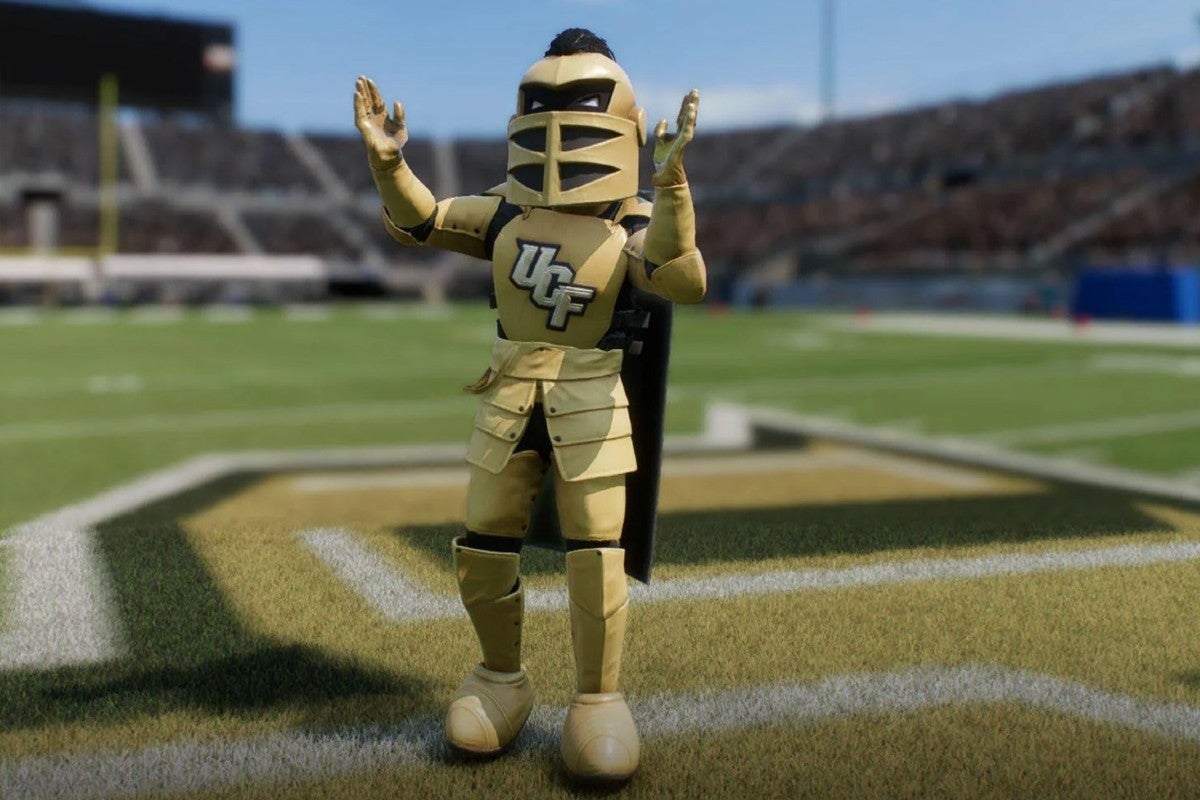For four seasons, FBC Mortgage Stadium was a home away from home for Victoria Torres ’24. As a trumpeter for the UCF Marching Knights, Torres was a part of the game day performances and tradition at UCF. Her time with the band also led to her developing a passion for the game of football. That same UCF game day experience is now captured in the long-awaited EA SPORTS College Football 25, with former Electronic Arts (EA) intern Torres playing a role in bringing gamers a realistic experience at the virtual Bounce House.
EA SPORTS College Football 25 returned July 19 after an 11-year hiatus. The simulation-style football game’s focus provides an authentic college football experience that is specific to each school, including UCF.
Game day elements that Knights fans are accustomed to are featured as part of College Football 25. Before kick-off, fans perform the signature U-C-F arm sign, while the team runs out the tunnel, running past the virtual Marching Knights playing UCF’s fight song, Charge On. When the ball is kicked off, the fans yell out “U-C-F Knights,” just as they do in real life. For the first time, real-life players will also be featured in the game, further replicating a realistic experience for gamers. UCF’s reputation of being a leader in space research and education is showcased through an occasional in-game rocket launch, like the real-life SpaceX Falcon 9 rocket launch during a game against Kent State in Fall 2023.
Behind the scenes, dozens of UCF alums, including 42 graduates of the university’s Florida Interactive Entertainment Academy (FIEA), helped to create College Football 25. FIEA, the world’s top-ranked graduate video gaming school, is located at UCF Downtown, across the street from EA Orlando and is a strong pipeline of talent to the game developer.
Torres, a digital media alum who earned a minor in marketing, is one example of the invaluable experience UCF students can gain through internships. Last summer, she modeled and textured indoor and outdoor environmental assets based on real-life photographs taken at FBC Mortgage Stadium and Raymond James Stadium in Tampa for College Football 25 and the Madden NFL series.
Torres and her team used many tools, including LiDAR scanners to capture the lighting in the stadium. One scanner was placed in the middle of the stadium and scanned the entire facility, creating a 3D model. They also used individual scanners to capture models ranging from trash cans to cleats, which were then modified to the smallest detail. For example, a trash can in the stadium was scanned, then designers patched up any topology errors or holes, and added digital trash cans into the game.
Beyond scanning, the team took pictures of everything. Torres captured chairs at every angle, so artists were able to replicate them easily. She used a color palette, placing it next to the chairs, to help pinpoint the exact colors. Torres also worked with a pen-like scanner that identified the exact hex color of an object, adding further detail.
When scanning 3D objects, Torres says the main thing she tried to keep in mind was making sure the environment, whether it’s a prop or a whole scene, tells a story. An example of this was the first prop she created for EA, a coffee table for Madden NFL. The designers wanted the table to be around one or two years old, so she referenced her own coffee table that was around that age, mimicking details such as rings left from cold glasses and hot plates.
“That’s something that you really need to have as an environment artist, you need that eye to tell a story of things as simple as a coffee table, that maybe most people won’t even notice,” Torres says. “I think that’s the main thing, and that’s something that I still follow today. And working on portfolio pieces now, just doing my very best to tell stories without there being text.”
The lessons Torres has learned over her career come from a variety of places and mentors, such as EA SPORTS Environment Director Ingrid Aguero ’07 ’08MS, a graduate of UCF’s FIEA program. As a student at UCF, the most useful information Torres says she learned was in the 3D modeling classes. Under the instruction of Nicholas Hunter ’17 ’18MS, an instructor in UCF’s games and interactive media program and a FIEA alum, Torres gained knowledge on how to make assets that have good topology and UV mapping, which serves as a bridge between 2D textures and 3D objects. Torres also learned how to use Autodesk Maya, the industry standard program.
After being gone for over a decade, College Football 25 means many things to fans who have clamored for the game. For Torres, it’s a combination of her favorite things — Knight Nation, UCF football and video games.
“It honestly doesn’t feel real, I have a piece of my work inside my alma mater, in a game that is making a comeback after 11 years,” Torres says. “Everyone’s hyped, and it’s … really cool to see the game.”




